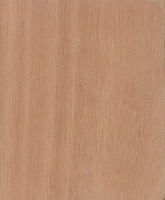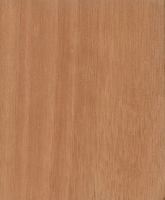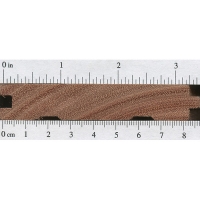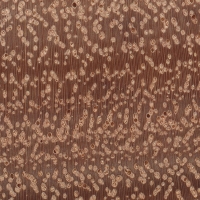 |
Common Name(s): Rose gum, flooded gum, red grandis Scientific Name: Eucalyptus grandis Distribution: Eastern Australia; also grown on plantations worldwide Tree Size: 100-165 ft (30-50 m) tall, 4-7 ft (1.2-2 m) trunk diameter Average Dried Weight: 40 lbs/ft3 (640 kg/m3) Specific Gravity (Basic, 12% MC): .48, .64 Janka Hardness: 1,260 lbf (5,600 N) Modulus of Rupture: 15,640 lbf/in2 (107.8 MPa) Elastic Modulus: 2,052,000 lbf/in2 (14.15 GPa) Crushing Strength: 8,020 lbf/in2 (55.3 MPa) Shrinkage: Radial: 5.9%, Tangential: 10.1%, Volumetric: 15.5%, T/R Ratio: 1.7 |
Color/Appearance: Heartwood color ranges from pink to reddish brown. Paler sapwood is sometimes indistinct from heartwood.
Grain/Texture: Usually straight-grained or shallowly interlocked, with a uniform medium to coarse texture.
Endgrain: Diffuse-porous; exclusively solitary; large to very large pores in no specific arrangement, few to very few; tyloses present; parenchyma vasicentric, confluent; narrow rays, spacing fairly close.
Rot Resistance: Rated as durable to very durable; poor insect resistance.
Workability: Fairly easy to work with both hand and machine tools, though Rose Gum experiences a large amount of shrinkage when drying, and a relatively large amount of movement in service. Glues, stains, and finishes well.
Odor: No characteristic odor.
Allergies/Toxicity: Besides the standard health risks associated with any type of wood dust, no further health reactions have been associated with Rose Gum, though several other species within the Eucalyptus genus have been reported to cause various allergic reactions. See the articles Wood Allergies and Toxicity and Wood Dust Safety for more information.
Pricing/Availability: Occasionally exported to North America. Available in good sizes and lengths in board form. Prices are moderate for an imported hardwood.
Sustainability: This wood species is not listed in the CITES Appendices or on the IUCN Red List of Threatened Species.
Common Uses: Flooring, millwork, furniture, and boatbuilding.
Comments: Rose Gum is a common plantation species, though a hybrid species marketed as Lyptus® is grown in Brazil: Rose Gum is bred with an Indonesian species (Eucalyptus urophylla) to help increase disease and insect resistance.
- Blue Gum (Eucalyptus globulus)
- Brown Mallee (Eucalyptus dumosa)
- Coolibah (Eucalyptus coolabah)
- Deglupta (Eucalyptus deglupta)
- Jarrah (Eucalyptus marginata)
- Karri (Eucalyptus diversicolor)
- Lyptus® (Eucalyptus urograndis)
- Messmate (Eucalyptus obliqua)
- Mountain Ash (Eucalyptus regnans)
- Red Mallee (Eucalyptus oleosa)
- River Red Gum (Eucalyptus camaldulensis)
- Swamp Mahogany (Eucalyptus robusta)
- White Box (Eucalyptus hemiphloia)
- Yellow Box (Eucalyptus melliodora)
- Yellow Gum (Eucalyptus leucoxylon)
None available.
Scans/Pictures: A special thanks to Per Stangegaard for providing the wood sample of this wood species.








Hi all,
Can anyone confirm if I shoud have some kind of mahogany or rose gum in my hands by these images?
Thanks in advance, and cheers!
Tamás
Hello Erik i got better detail photo in 46 mega pixel off endgrain. And Macro detai off wood.
Hello Erik, friend bring for mine wood from Spian. I sand the wood to grit 1200 i think endgrain look like Rose Gum. Mine wood is arround 900 kg / m3. It is not easy to sand. Can you please confirm ? Thx alot Tomas
I agree that it appears to be a species of Eucalyptus, but if the wood is around 900 kg/m3, then it’s probably not rose gum. There are hundreds of different species, so it’d be hard to say for sure. But E. diversicolor is a commercial species sold as karri that seems to fit your description closest. https://www.wood-database.com/karri/
Thx so much Erik for help of identify his wood. Is heavy and hard to saw and sand also. You are the best.
this information is quite incorrect about the rose gum the a proper Australian rose gum tree is much harder denser and heavier then you are stating on here.l I know this for a fact.Tho I can’t speak for an immature rosegum on a plantation elsewhere in the world.
Do you have any references for your facts? Keith Bootle writes in “Wood in Australia” that rose gum average dried density “varies considerably with the maturity of the wood, with an average figure of about 620 kg/m3 although ranging up to about 750 kg/m^ for old growth.”
As the site is interested in reflecting AVERAGE values and not outliers, my number of 640 kg/m3 is actually slightly higher than Bootle’s listed average of 620 kg/m3.
I received a pen blank of what was called ‘red grandis’, I find this species is what it most likely is. Can anyone confirm?
Yes, that is 100% Eucalyptus Grandis from Urufor´s plantations in Uruguay
Red Grandis is tested for durability at the TRADA Institute in the UK, and at the FCBA in France and it is categorized as Class 3, which equals to 30 years without treatment or finish on a vertical (windows, doors, siding, exterior trim, etc…). Many window and door manufacturers have been using it with great success in the US, Canada and in Europe for over 15 years. Durable, stable, green and good savings too
Eucalyptus grandis needs to be treated to H3 or H4 for outdoor use (South African Standard quoted). Poles are creosoted or treated with CCA in South Africa. See https://Www.sawpa.co.za for more details.
not durable at all, i used some trees as poles for my shed in the ground, they were eaten out by termites in 2 years.
strictly an internal timber for furniture etc i reckon..
With not treatment at all?
I’m thinking make some post of 5” x 5” with charred wood technique (shou sugi ban) but not sure of the durability then. (also painting the underground base for prevent water damage)
Rose Gum or Red Grandis is not at all good IN THE GROUND. above the ground it is very good vs rot and fungus, but still not good against termites.